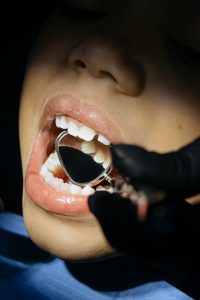 On the off chance that your child has a loose tooth that is disturbing him or her, you may think about whether or not you should help to pull it out or simply exercise patience and wait for it to come out on its own. It may be tempting to remove the tooth from your child’s mouth; however, this isn’t generally the most ideal approach to take. Here are some things to consider before removing or pulling a loose tooth.
On the off chance that your child has a loose tooth that is disturbing him or her, you may think about whether or not you should help to pull it out or simply exercise patience and wait for it to come out on its own. It may be tempting to remove the tooth from your child’s mouth; however, this isn’t generally the most ideal approach to take. Here are some things to consider before removing or pulling a loose tooth.
Why Is The Tooth Loose?
A loose tooth does not always indicate that a permanent tooth is coming. Children sometimes hit their teeth as they play or fall. If your child’s tooth has become loose because it was hit, you should arrange a meeting with your dentist for inspection as there may be a risk of infection or permanent dental damage.
First Tooth In, First Tooth Out
Children usually lose their teeth in the same order they get them. Teeth in the front go first, usually at about six or seven years of age. When the permanent tooth begins to penetrate the roots, the child’s teeth dissolve until it is loose enough to fall without pain and with very little blood.
If the loose tooth in your child’s mouth is not ready to come out, of course, extraction attempts can pull off their sensitive roots and cause unnecessary pain. If you are not sure why a tooth is loose and appears premature or out of order for your child, you can arrange to visit.
The Best Ways To Help Out A Loose Tooth
The American Dental Association produced a video that describes the gentle removal of a loose tooth. However, before doing this, make sure the tooth is very loose or hangs in the cavity. Also, make sure your child does not feel any pain when pressing the tooth. If your child feels pain, it is a sign that the roots are not sufficiently dissolved to safely remove the tooth. Gently take your tissue, wrap it around the tooth, and squeeze it. The tooth should lightly fall.
DO NOT Pull Your Child’s Tooth If
- It is just a little loose. Teeth like this can still be firmly rooted in the cavity.
- Your child says he/she has pain every time he touches or pulls the tooth.
- You have not made contact with your dentist. We want to provide you with the information we need to help you determine the best things for your child’s teeth.
- Pulling the loose tooth can cause damage to teeth on the other side.
Loose Tooth Come Out On Their Own
For the most part, in the event that you and your child can withstand the nuisance of a loose tooth, it is better not to pull it out, but instead let them wiggle it until the point when it falls out by itself. This will limit the pain and bleeding related to tooth loss. On the off chance that you have any uncertainty about a loose tooth, contact Children’s Dentistry of San Diego.











